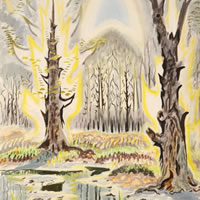 Beyond the Notes:
Beyond the Notes:
Watercolors
Burchfield and Synesthesia
Charles Burchfield is thought to have had synesthesia. Although we can't be sure (Burchfield himself never addressed it), some scholars find ideas in his art and journals that are distinctly synesthetic in character.
Synesthesia, know as the "crossing of the senses", is a neurological characteristic that can take many forms. It is not limited to artistic individuals (prominent synesthetes include physicist Richard Feynman and engineer Nikola Tesla), but synesthetic responses have fueled the work of many of artists--including composer Nell Shaw Cohen, who experiences moving, colored imagery in response to music, as well as musical ideas in response to visuals.
Explore the videos and images below to learn more about synesthesia, and the inspiration Burchfield drew from the imagery he experienced in response to sound and music.
An Introduction to Synesthesia
This video features an interview with renowned New York-based painter Carol Steen, co-founder of the American Synesthesia Assocation, who curates exhibits of synesthetic art and conducts innovative research into the expressions of synesthesia through visual art.
Burchfield's Influences from Music and Sound
Music had major influence on Burchfield's paintings and his aesthetic. From Burchfield's early days in art school when he idolized composer Richard Wagner and sketched abstract symbols representing musical motifs from the opera "Siegfried", to the maturity of his career when he drew on Beethoven and Sibelius for inspiration in his large-scale watercolor paintings, music served as an ongoing source of inspiration and a reference point for his artwork.
Video: Music in Burchfield's Paintings